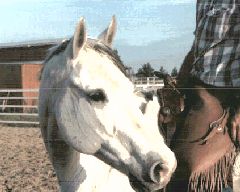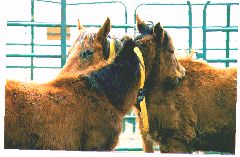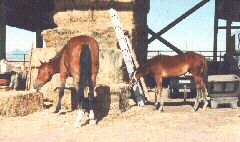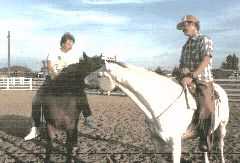Behavioral Factors when Training Feral, Unhandled and Problem Horses |
A little riding au natural on Teego
|
|
Horses are social animals. They are naturally drawn to other animals that they don't fear. Horses can become close friends with goats, dogs, cats even a chicken. The horse will generally accept the presence of the human who makes a concerted effort to be
non-threatening. Once accepted, a careful handler will trigger the horse's curiosity, the horse will check out the handler and record the handler as being either "OK" or "NOT OK". Thus it is not so strange that a horse and human can become friends.
This relationship becomes important when the handler and the new horse explore his new world. Most horses are intensely curious and so long as the handler isn't dragging him around, the new horse should enjoy this "learning" process and he should adjust to new things relatively quickly. I don't mean to say he won't spook when something surprises him, but he will be less likely to lose control of his emotions since his confidence in his human companion and himself will be high.
Horse herds have specific social orders, otherwise there would be chaos in the natural equine environment. Thus, every horse has a scorecard and ranks every other "horse" in his social circle. This is important since if Leader #1 disappears for some reason, Leader #2 needs to quickly take over without a string of arguments ensuing among all the horses as to who is now in charge. Horses are generally comfortable being around superior beings as it is less work to be a follower than it is a leader. However in the absence of recognizable leadership, the horse's instincts will drive him to take control. It should be noted that selecting social buddies, the creation of "sympathetic pairs" and the ranking of horses as leaders are altogether independent issues. The trainer, who may be different than the owner or adopter or handler, must establish himself as a higher ranking individual in the herd order than the horse which he is training. While he may otherwise be able to "make" the horse do something, it will be accomplished with some degree of reluctance or perhaps out of fear. In order to get the horse to respond, the handler has to first earn the horse's respect. (How to accomplish this is discussed later.)
As the horse views the various humans in his world, he may score some of them highly on the leadership scale, but not appreciate them as much as his reciprocal buddy, or with the scorecards reversed, the horse could view the human as a walking carrot dispenser who brings pleasure but deserves no respect. Obviously the human who scores low on both counts is in for a hard time and the human who can top the charts as both a leader and buddy should find the going comparatively easy. Continue to Part 2; How to establish yourself as a leader Press Back to return to the page which brought you hereGo to KBR Training SectionGo to LRTC Wild Horse MentorsGo to KBR World of Wild Horses & BurrosGo to other Wild Horse LinksGo To
|





